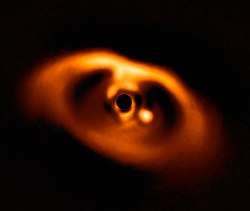Kepler-1625b I
Kepler 1625b I, a possible moon of exoplanet Kepler-1625b, may be the first exomoon ever discovered (pending confirmation), and was first indicated after preliminary observations by the Kepler Space Telescope. A more thorough observing campaign by the Hubble Space Telescope took place in October 2017, ultimately leading to a discovery paper published in "Science Advances" in early October 2018. Studies related to the discovery of this moon suggest that the host exoplanet is up to several Jupiter masses in size, and the moon is thought to be approximately the mass of Neptune. There is a possibility that the large exomoon may have a moon itself, called a moonmoon (or a "moon of a moon").[2] Kepler-1625b I may be habitable, considering the host planet has an equilibrium temperature of 253 K (−20 °C; −4 °F).[1][3][4][5][6]
.tif.jpg)
However, a reanalysis of the data published in April 2019 concluded that the data was fit better by a planet-only model. According to this study, the discrepancy was an artifact of the data reduction, and Kepler-1625b I likely does not exist.[7]
References
- Chou, Felicia; Villard, Ray; Hawkes, Alison; Brown, Katherine (3 October 2018). "Astronomers Find First Evidence of Possible Moon Outside Our Solar System". NASA. Retrieved 5 October 2018.
- Forgan, Duncan (4 October 2018). "The habitable zone for Earthlike exomoons orbiting Kepler-1625b". arXiv:1810.02712v1 [astro-ph.EP].
- Teachey, Alex; Kipping, David M. (3 October 2018). "Evidence for a large exomoon orbiting Kepler-1625b". Science. 4 (10): eaav1784. arXiv:1810.02362. Bibcode:2018SciA....4.1784T. doi:10.1126/sciadv.aav1784. PMC 6170104. PMID 30306135.
- "The Extrasolar Planet Encyclopaedia — Kepler-1625 b I".
- Drake, Nadia (3 October 2018). "Weird giant may be the first known alien moon - Evidence is mounting that a world the size of Neptune could be orbiting a giant planet far, far away". National Geographic Society. Retrieved 6 October 2018.
- "Hubble finds compelling evidence for a moon outside the Solar System - Neptune-sized moon orbits Jupiter-sized planet". SpaceTelescope.org. Retrieved 6 October 2018.
- Laura Kreidberg; Rodrigo Luger; Megan Bedell (24 April 2019), No Evidence for Lunar Transit in New Analysis of HST Observations of the Kepler-1625 System, arXiv:1904.10618, doi:10.3847/2041-8213/ab20c8
